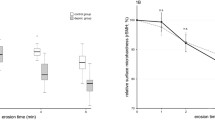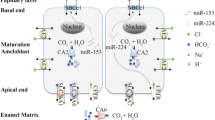Summary
The solubility characteristics, amino acid composition and molecular size, and aggregation of the protein components of the organic matrix of bovine and rat enamel have been studied as a function of progressive stages in the maturation of the tissue. The age of the animal, type of tooth and location of the enamel on the crown of the tooth and the amount of calcification were used as indices of enamel maturation in the bovine species, whereas location of the anemel on the tooth crown was used as an index of maturation in the rat.
The most immature enamel contains about 15–20% protein by weight, whereas the most mature enamel contains 0.1% protein or less. The proteins in the organic matrix of immature enamel are relatively insoluble in near neutral solutions of 0.5 M EDTA and are characterized by their high concentrations of proline, glutamic acid, leucine, and histidine (“immature” protein components). Conversely the proteins and peptides of fully mature enamel are soluble in 0.5 M EDTA and are characterized by their relatively high concentrations of aspartic and glutamic acids, serine and glycine (“mature” protein and peptide components). The very marked decrease in the protein content of maturing and mature enamel, and the differences in amino acid composition of mature enamel compared with immature enamel, suggest that maturation of enamel is characterized biochemically by the selective loss of certain peptides and the retention of certain other peptides, the latter possibly due to their interaction with the mineral ion constituents.
The biochemical processes accompanying maturation appear to begin early in the development of the enamel at a time when the organic matrix and its protein constituents are immature as judged by their insolubility in EDTA and by their overall amino acid composition. In consists of the selective loss and the selective retention of certain components from the enamel which tend to decrease the proline and histidine contents and increase the serine, aspartic acid and glycine contents of the immature, EDTA-insoluble matrix, the latter components also becoming diffusible and suggesting protein and/or peptide degradation or depolymerization. Despite the changes in the overall composition of the immature, EDTA-insoluble enamel matrix which occur as a function of progressive stages in the maturation process, they all contain soluble, nondiffusible components of similar composition which are rich in proline, histidine and leucine.
At stages of development intermediate between the most immature and the fully mature states, the enamel matrix contains a mixture of “immature” and “mature” proteins, the relative proportions of which are principally responsible for its overall amino acid composition. However, since the progressive biochemical changes of maturation are first observed in the immature, EDTA-insoluble enamel matrix, these changes also contribute to the overall differences in the amino acid composition.
There is no evidence that the overall compositional changes in the enamel at any stage of development is due principally to compositional changes in the individual protein and peptide components per se. It is proposed that if peptide bond hydrolysis occurs during enamel maturation, it is catalysed in part by the enamel crystals per se.
Similar content being viewed by others
References
Brickley, D.M., Glimcher, M.J.: The biosynthesis of chick bone collagen crosslinks (abstract). Fed. Proc.32, 649 (1973)
Brickley, D., Glimcher, M.J.: The biosynthesis of crosslinkages of collagen in chick bone growing in tissue culture (abstract). J. Bone Joint Surg. [Am]55, 651 (1973)
Brickley Parsons, D., Glimcher M.J.: Temporal relationships in the formation of the reducible intramolecular and intermolecular crosslinkages of cartilage collagen studied in organ culture (abstract). Trans. 22nd Ann. Meeting Orthop. Res. Soc.1, 31 (1976)
Burgess, R.C., Maclaren, C.M.: Proteins in developing bovine enamel. In: Tooth enamel: Its composition, properties and fundamental structure (M.V. Stack and R.W. Fearnhead, eds.), pp. 74–82. Bristol: Wright 1965
Deakins, M.: Changes in the ash, water, and organic content of pig enamel during calcification. J. Dent. Res.21, 429–435 (1942)
Eastoe, J.E.: Organic matrix of tooth enamel. Nature (London)187, 411–412 (1960)
Eastoe, J.E.: The amino acid composition of proteins from oral tissues: II. The matrix proteins in dentine and enamel from developing human deciduous teeth. Arch. Oral Biol.8, 633–652 (1963)
Eastoe, J.E.: Dental enamel. In: Comprehensive biochemistry M. Florkin and E. Stotz, eds.), Vol. 26, pp. 785–834. New York: Elsevier, 1971
Eggert, F.M., Allen, G.R., Burgess, R.C.: Purification and partial characterization of proteins from developing bovine dental enamel. Biochem. J.131, 471–484 (1973)
Elwood, W.K., Apostolopoulos, A.X.: Analysis of developing enamel of the rat: I. Fractionation, protein and calcium content. Calcif. Tiss. Res.17, 317–326 (1975)
Elwood, W.K., Apostolopoulos, A.X.: Analysis of developing enamel of the rat: II. Electrophoretic and amino acid studies. Calcif. Tiss. Res.17, 327–335 (1975)
Fincham, A.G.: Electrophoretic and sephadex gel filtration studies of bovine foetal enamel matrix at acid pH. Calcif. Tiss. Res.2, 353–360 (1968)
Friberg, U.A., Levine, P.T., Glimcher, M.J.: An air-abrasive method for the microdissection of mineralized tissues. Biol. Bull.126, 253–263 (1964).
Fukae, M.: Biochemical studies of enamel formation (in Japanese). J. Biochem.37, 295–303 (1970)
Fukae, M., Shimizu, M.: Studies on the proteins of developing bovine enamel. Arch. Oral Biol.19, 381–386 (1974)
Fukae, M., Shimokawa, H., Iwakura, M., Suda, T., Sasaki, S.: Studies of the biosynthesis of enamel proteins in the rat by use of3H-proline (abstract). J. Dent. Res.51, 1298 (1972)
Glimcher, M.J., Bonar, L.C., Daniel, E.J.: The molecular structure of the protein matrix of bovine dental enamel. J. Mol. Biol.3, 541–546 (1961)
Glimcher, M.J., Friberg, U.A., Levine, P.T.: The identification and characterization of a calcified layer of coronal cementum in erupted bovine teeth. J. Ultrastruct. Res.10, 76–88 (1964)
Glimcher, M.J., Friberg, U.A., Levine, P.T.: The isolation and amino acid composition of the enamel proteins of erupted bovine teeth. Biochem. J.93, 202–210 (1964)
Glimcher, M.J., Levine, P.T.: Studies of the proteins, peptides and free amino acids of mature bovine enamel. Biochem J.98, 742–753 (1966)
Glimcher, M.J., Mechanic, G., Bonar, L.C., Daniel, E.: The amino acid composition of the organic matrix of decalcified fetal bovine dental enamel. J. Biol. Chem.236, 3210–3213 (1961)
Glimcher, M.J., Mechanic, G.L., Friberg, U.A.: The amino acid composition of the organic matrix and the neutral soluble and acid soluble components of embryonic bovine enamel. Biochem. J.83, 198–202 (1964)
Glimcher, M.J., Travis, D.F., Friberg, U.A., Mechanic, G.L.: The electron microscopic localization of the neutral soluble proteins of developing bovine dental enamel. J. Ultrastruct. Res.10, 362–376 (1964)
Katz, E.P., Mechanic, G.L., Glimcher, M.J.: The ultracentrifugal and free zone electrophoretic characterization of the neutral soluble proteins of embryonic bovine enamel. Biochim. Biophys. Acta107, 471–484 (1965)
Katz, E.P., Seyer, J.M., Levine, P.T., Glimcher, M.J.: The comparative biochemistry of the organic matrix of developing enamel: II. Ultracentrifugal and electrophoretic characterization of proteins soluble at neutral pH. Arch. Oral Biol.14, 533–539 (1969)
Krane, S.M., Glimcher, M.J.: Transphosphorylation from nucleoside di- and triphosphates by apatite crystals. J. Biol. Chem.237, 2991–2998 (1962)
Levine, P.T., Glimcher, M.J.: The isolation and amino acid composition of the organic matrix and neutral soluble proteins of developing rodent enamel. Arch. Oral Biol.10, 753–756 (1965)
Levine, P.T., Glimcher, M.J.: Changes in the amino acid composition of the organic matrix of enamel with maturation (abstract). Int. Assoc. Dent. Res. Abs.46, 84 (1968)
Levine, P.T., Seyer, J.M., Huddleston, J., Glimcher, M.J.: The comparative biochemistry of the organic matrix proteins of developing enamel: I. Amino acid composition. Arch. Oral Biol.12, 407–410 (1967)
Mandl, I.: Collagenases and elastases. Advan. Enzymol.23, 161–264 (1961)
Mechanic, G.L.: The multicomponent re-equilibrating protein system of bovine embryonic enamelin (dental enamel protein): Chromatography in deaggregating solvents. In: Tooth enamel II. Its composition, properties and fundamental structure (R.W. Fearnhead and M.V. Stack, eds.), pp. 88–94. Bristol: Wright 1971
Mechanic, G.L., Katz, E.P., Glimcher, M.J.: The Sephadex gel filtration characteristics of the neutral soluble proteins of embryonic bovine enamel. Biochim. Biophys. Acta133, 97–113 (1967)
Shapiro, F., Brickley Parsons, D., Glimcher, M.J.: In vivo biosynthesis of collagen crosslinks in articular cartilage. Trans. 22nd Ann. Meeting Orthop. Res. Soc. (abstract).1, 30 (1976)
Shimokawa, H., Sasaki, S.: Biosynthesis of enamel protein in vitro. (abstract). J. Dent. Res.54A, 107 (1975)
Stack, M.V.: Chemical organization of the organic matrix of enamel. In: Structural and chemical organization of teeth, Vol 2 (A.E.W. Miles, ed.), pp. 317–346. New York: Academic Press 1967
Suga, S.: Histochemical observation of proteolytic enzyme activity in the developing dental hard tissues of the rat. Arch. Oral Biol.15, 555–558, (1970)
Travis, D.F., Glimcher, M.J.: The structure and organization of, and the relationship between the organic matrix and the inorganic crystals of embryonic bovine enamel. J. Cell Biol.23, 447–497 (1964)
Weidmann, S.M., Eyre, D.R.: The protein of mature and foetal enamel. In: Tooth enamel II: Its composition, properties and fundamental structure (R.W. Fearnhead and M.V. Stack, eds.), pp. 72–78. Bristol: Wright 1971
Author information
Authors and Affiliations
Rights and permissions
About this article
Cite this article
Glimcher, M.J., Brickley-Parsons, D. & Levine, P.T. Studies of enamel proteins during maturation. Calc. Tis Res. 24, 259–270 (1977). https://doi.org/10.1007/BF02223326
Received:
Accepted:
Issue Date:
DOI: https://doi.org/10.1007/BF02223326




